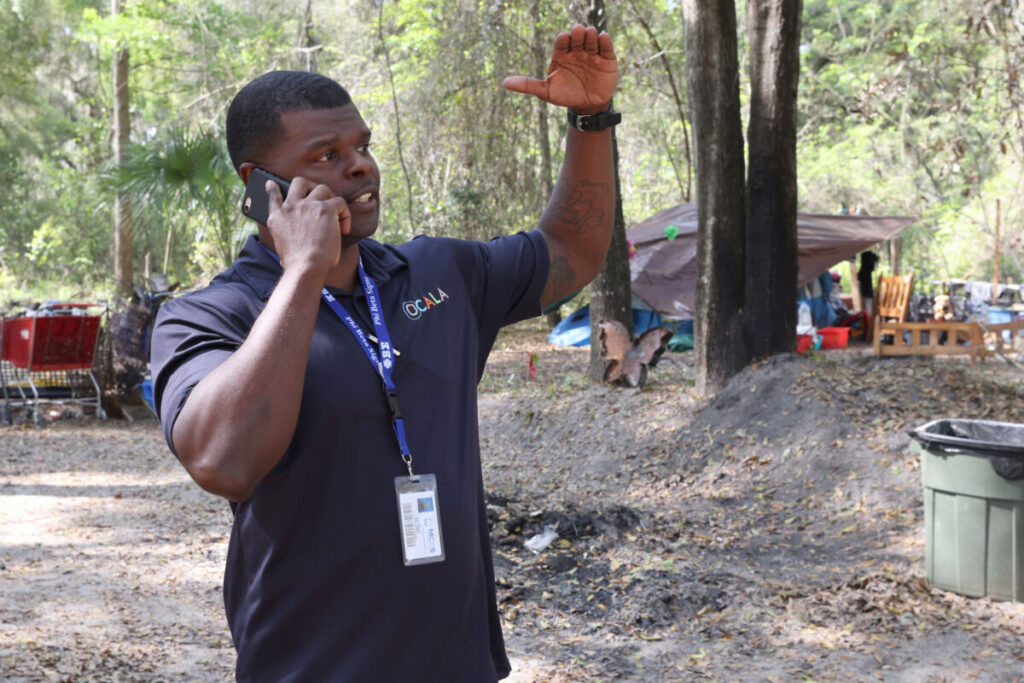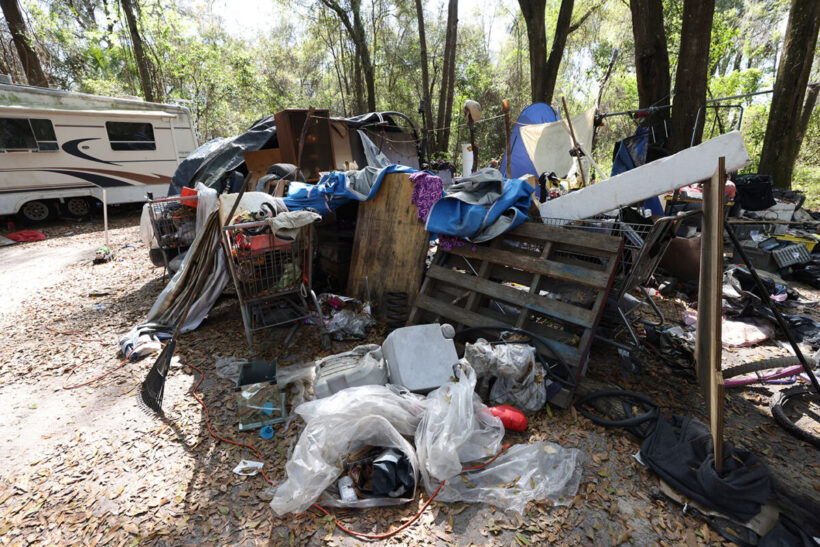Homelessness dilemma grows
As the numbers of the unsheltered increases locally, area agencies try to meet the need.

Cletus Gibbs of the Department of Homeless Prevention talks on his cellphone as he tries to locate other places for homeless people to stay as a homeless camp on the private property of Khalid Mirza is broken up off Northwest 38th Avenue in Ocala on Tuesday, March 7, 2023. [Bruce Ackerman/Ocala Gazette] 2023.
Editor’s note: In coming weeks, the “Gazette” will explore other aspects of this subject, such as the role of nonprofits and barriers to shelter.
Steve C. compares his homelessness to being trapped in a dark tunnel.
“There’s no way out,” he said.
Steve, 53, a native of Pennsylvania who says he’s been homeless for “quite a while,” said things began to unravel for him when his wife died and he “overdosed twice.” He was most recently living in a tent in a camp in the 700/800 block of Northwest 38th Avenue that he said was a “peaceful” place. Around 30 other people and three RVs were on the 68-acre parcel out of view from the main road—until the owner came to town to check on his property with a possible sale pending.
Law enforcement officials issued trespass warnings to those living at the site. Many of the homeless have since struggled to find somewhere else to live in the aftermath.
This is just the latest example of a growing problem in Marion County and elsewhere, where communities are trying to help the less fortunate meet a basic human need: shelter.
Field workers from the Office of Homeless Prevention (OHP), the local agency that provides critical outreach efforts to connect the homeless with available services, had visited the encampment as far back as September, a city spokesperson said. OHP returned to the encampment after the police ordered those living there to leave.
There are a number of services available in Marion County, both government-related as well as private or through church-based organizations. There also is a project expected to be finished later this year that will create a day center providing everything from meals, laundry facilities and showers to resources to locate birth certificates and other records.
In some instances, however, there appears to be a disconnect between these services and the people they are intended to help.
Infrastructure
To gain an understanding about how government, private, and charitable groups are involved, the “Gazette” reached out to several local groups for an update on a major undertaking that started in 2017 to address the homelessness in Marion County.
That year, the not-for-profit Marion County Public Policy Institute, or PPI, began a study called “Homelessness: The Long Way Home.” The PPI published recommendations two years later in the areas of leadership, comprehensive planning and funding.
One recommendation was to eliminate the Marion County Homeless Council and form the Ocala/Marion Joint Office of Homeless Prevention. The OHP was established in July 2020. Marion County staff primarily oversee funding and grant applications, while the Ocala staff handles outreach efforts and operates the Homeless Management Information System (HMIS), which is used by nonprofits to store client information and to avoid duplication of services.
Getting an accurate count of the unsheltered in Marion County is problematic given their nomadic nature. Add in that many homeless people would prefer not to be found and the challenge can be daunting.
An annual Point In Time count, which attempts to locate and record the numbers of homeless people in Marion County, indicated that for 2022, there were 488 people in shelters and 188 people unsheltered.
In September 2022, Scot Quintel took over as Continuum of Care manager for the OHP. The Continuum of Care is a partnership of public and private agencies that help the homeless and try to keep people in borderline situations from becoming homeless.
Quintel said a vulnerability index that is used to prioritize homeless individuals for receiving services currently lists 61 individuals and 17 families.
The OHP remains busy providing services to the area’s homeless, Ashley Dobbs, City of Ocala Marketing and Communication Manager/Office of Strategic Engagement, said in an email.
“Since October 2020 through February 2023, the (OHP) has provided 6,242 assistances and follow-ups to homeless clients,” she said. The OHP, along with the service providers in the CoC, have helped 474 people find homeless resolutions including those in rapid-rehousing programs, permanent supportive housing programs, Emergency Housing Voucher Programs, and those that can self-resolve after an emergency shelter stay, Dobbs said.
A HUD report for the local Continuum of Care for 2017 to 2021 had some intriguing findings about the effectiveness of some of these efforts.
The report showed that while the number of homeless increased, there was also a higher number of people moving into permanent housing. The report notes the “average length of time homeless” went from 69 days in 2020 to 82 in 2021, while the “number of people who are homeless for the first time” went from 644 in 2020 to 1,046 in 2021.
Meanwhile, the report found people moving from emergency shelter and three other types of temporary housing into permanent housing went from 9.1% in 2020 to 34.5% in 2021.
There are other efforts bearing fruit, Dobbs said. Since Jan. 1, 2020, the Ticket Home program has helped 125 people move to another area where they will have a place to live. And, in September 2021, OHP partnered with the Ocala Housing Authority to administer the Emergency Housing Voucher Program. The Ocala Housing Authority has issued 51 housing vouchers and 35 of these clients have secured housing through leases and are no longer homeless, Dobbs said.
Importantly, OHP helps those considered “literally homeless,” people without a fixed nighttime residence. These are people living in an emergency shelter or in a vehicle, encampment, or a place not considered habitable because there is no running water or electricity.
People like Steve and the others recently rousted from the encampment.
Personal perspectives
The camp evidently was established about a year ago by Arthur, who did not wish to give his last name. He was working at a nearby motel but, he said, he was fired for helping homeless people with meals. Arthur, formerly of San Antonio, Texas, claimed he had an OK from the property owner through a “real estate” representative to be on the property.
That was news to Khalid Mirza of Miami, owner of the parcel, who came to Ocala to check on the property with a possible sale pending.
Ocala Police Department call logs indicate that Mirza called on March 1 after he arrived at the wooded property and found multiple tents and trailers on the site and was “afraid to enter.”
“I called OPD (because) I did not give these people permission to be on the property. I feel bad for them,” Mirza said in a telephone interview. He acknowledged unsafe and unsanitary conditions in the encampment and called homelessness “a societal problem (in the) richest country in the world.”
On March 3, OPD issued trespass warnings to 15 people, ranging in age from 32 to 66, who were told to vacate the property by March 6. On March 7, OPD issued three notices to appear in court to people ages 33, 49 and 66.
Arthur complained about what he said was a short time frame to vacate the property. “We need some kind of help,” he said. “We have handicapped people.’’
Dobbs said OHP outreach workers “have visited the camp since September 2022 and outreach workers responded to the camp after notification by OPD of the March 3 trespass warnings. Specialists offered to assist clients with receiving emergency shelter, substance abuse recovery resources and transportation assistance to the emergency shelter,” she wrote in a March 10 email.
Steve said he didn’t see any OHP workers between when the trespass notices were served and the deadline to vacate the property. He said he had encountered them previously. “I was approached by city workers early on …mainly (offering help with) substance abuse,” he said.
Now, Steve doesn’t know where he will stay. “I’ll go on the streets or perhaps check on the Salvation Army,” he said.
The barriers to shelter
Not all emergency shelters are created equal. Some are high-barrier shelters, which have identification and criminal record screening requirements. There also are low-barrier shelters, but not in Marion County.
“Our emergency shelters are not low-barrier and many of our unsheltered do not meet the requirements to enter or remain in these shelters,” Dobbs noted. “Those in the shelters have specific time limits so that others can enter the shelter and work through their programs and receive case management. We do not have a low-barrier shelter in our area, and many clients in our encampments have been to shelter(s) in the past and are not allowed back in due to various reasons.’’
Quintel agreed that some of the homeless cannot enter the local shelters due to their criminal record. “Currently, there is no place for these individuals to be sheltered. This is a gap in the homeless services system we are working to address,” he said.
Becky Reynolds, director of social services with the Salvation Army in Ocala, said a person displaced from the camp could have had a bed the same night if they had the proper identification and pass background check requirements.
One of the people who moved off the property after the dispersal of the camp was a 40-year resident of Marion County who said they are now “clean and sober” and working with a solid waste company. Another former encampment member said he is getting help through the Marion County Mental Health Court Program.
For Paul L., 57, the camp was the third he has lived in over the last 15 months. He said he was removed from a camp near OPD and one near Rural King. He said it’s hard to maintain his job as a cook when living in camp conditions and that a person cannot always have a clean appearance for a job in a kitchen that is often open for customers to observe.
“It’s tough. Out of sight is out of mind,” he said.
Combined efforts
According to HUD, the CoC award amount for 2021 was $489,464. The housing-related funding included $29,242 to Greater New Hope Church; $86,215 to Interfaith Emergency Services; $37,144 to the Ocala Housing Authority; $55,552 to the OHP for project application; and three awards to Shepherd’s Lighthouse totaling $281,311.
In addition, private nonprofits including St. Theresa Catholic Church in Belleview, Saving Mercy, Open Arms Village of Ocala, LifeStream Behavioral Center at Beacon Point, Brother’s Keeper, Estella Byrd Whitman Wellness & Community Resources Center, Creative Services, and Marion County Veterans Helping Veterans are involved in the Continuum of Care.

Part of a homeless campsite is shown as a homeless camp is broken up on the private property of Khalid Mirza off Northwest 38th Avenue in Ocala on Tuesday, March 7, 2023. [Bruce Ackerman/Ocala Gazette] 2023.
Quintel said the PPI study recommends more outreach workers and creating a “central access point” for homeless persons to seek help. He said the SMA Healthcare (formerly the Centers) has two field outreach care managers and the OHP has four. He said more field outreach managers are needed but there is no hiring time frame.
“Outreach personnel attempt to connect unsheltered clients with emergency shelters if they are willing,” Dobbs said. They interview the client in-depth to verify their homeless status and establish what other services outside of housing the client may need, such as substance abuse recovery, mental health, medical, transportation and life-skills training.
“We have partnered with SMA Healthcare, and they ride with our outreach personnel on a regular basis offering services specifically related to mental health and substance abuse and recovery programs,” she said.
Dobbs noted that the city of Ocala “provides the salary for five (OHP) employees, which allows more of the grant funding to go directly to housing programs.”
Finding affordable housing is a huge challenge today, particularly for the homeless.
“The lack of income-based housing is a monumental barrier for our CoC,’’ Dobbs said. “Case managers and housing locators must work with private landlords to obtain housing. Our clients often have criminal histories and/or evictions in their rental history and are difficult to place in the private rental market.
“Rental rates have risen so dramatically over the past three years,’’ she added, “and we have seen many clients who were stably housed on a fixed income become homeless due to huge rental increases when their leases renewed. During and after the pandemic, numerous properties were sold, and the new owners raised prices dramatically.”
A glimmer of hope
Dobbs noted the ongoing need for a day center where the homeless can receive services in a congregate setting on a regular basis. These services include help obtaining birth certificates, Social Security/disability or VA benefits, job training and child-care services. The center could also provide services for those not in a shelter, such as laundry services and showers.
Quintel said a “central access point” or location similar to a fenced area near Interfaith Emergency Services, known as “Agape Park,” with some daytime facilities, is planned.
Karla Grimsley-Greenway, CEO of Interfaith Emergency Services, the agency handling the central access point, said the facility is slated to be up and running by year’s end, tentatively in the 400 block of Northwest Second Street.
“We are building an engagement center to be a central point of access and hopefully help these individuals navigate all of their challenges to housing,’’ she said. “The plans have been approved and we are about to start the bidding process. Hopefully, it will be completed by the end of the year, and the funding will partially come from the county (and) partially through Interfaith fundraising efforts. This will be a center where the homeless will have individual case management and other support services. It will also serve as a day center where they can get soft job training skills.”
As the local agencies continue to work together, many of the workers and volunteers hope for positive outcomes and for community engagement.
“There is a need for a low-barrier shelter in the area, but we’d also like to see the entire community get involved in helping the homeless. Housing is a human need,” said Reynolds.





